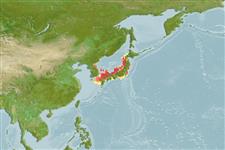Common names from other countries
Environment: milieu / climate zone / depth range / distribution range
Οικολογία
μη μεταναστευτικό(ά) (Ref. 75927); εύρος βάθους 1 - 200 m (Ref. 275), usually ? - 150 m (Ref. 75927). Temperate; 44°N - 30°N, 128°E - 145°E (Ref. 275)
Northwest Pacific: Japan, Korea and China.
Length at first maturity / Μέγεθος / Βάρος / Age
Maturity: Lm ?, range 50 - ? cm Max length : 70.0 cm TL αρσενικό/απροσδιόριστο; (Ref. 275)
Combination depth range: min from estimate, max from literature.
Members of the class Cephalopoda are gonochoric. Male and female adults usually die shortly after spawning and brooding, respectively. Mating behavior: Males perform various displays to attract potential females for copulation. During copulation, male grasp the female and inserts the hectocotylus into the female's mantle cavity where fertilization usually occurs. Life cycle: Embryos hatch into planktonic stage and live for some time before they grow larger and take up a benthic existence as adults.
Roper, C.F.E., M.J. Sweeney and C.E. Nauen. 1984. (Ref. 275)
IUCN Red List Status (Ref. 130435)
CITES status (Ref. 108899)
Not Evaluated
Not Evaluated
Threat to humans
Harmless
Human uses
αλιεία: Εμπορικό(ά)
| FishSource |
Εργαλεία
Περισσότερες πληροφορίες
Age/SizeΑύξησηLength-weightLength-lengthΜορφολογίαΠρονύμφεςΑφθονία
Διαδικτυακές πηγές
Estimates based on models
Vulnerability
Moderate to high vulnerability (48 of 100).
